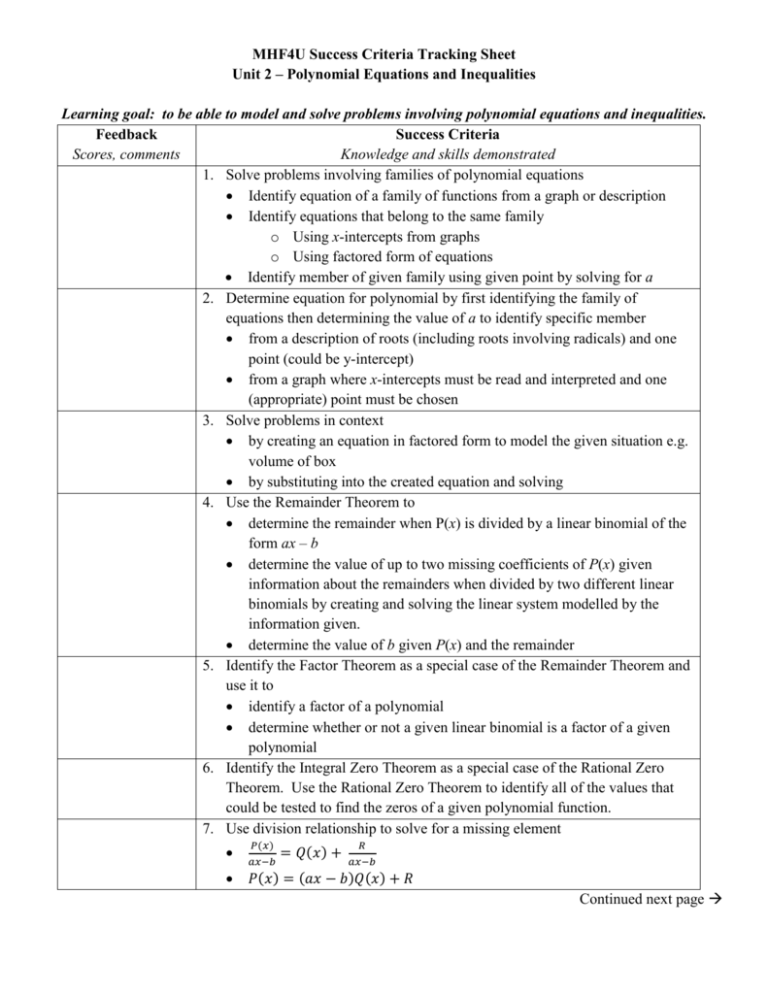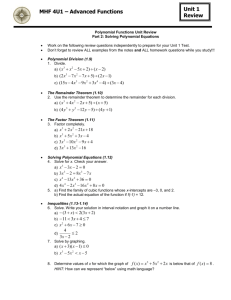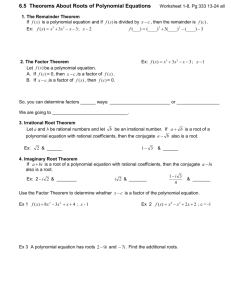Polynomial Equations & Inequalities: Success Criteria
advertisement

MHF4U Success Criteria Tracking Sheet Unit 2 – Polynomial Equations and Inequalities Learning goal: to be able to model and solve problems involving polynomial equations and inequalities. Feedback Success Criteria Scores, comments Knowledge and skills demonstrated 1. Solve problems involving families of polynomial equations Identify equation of a family of functions from a graph or description Identify equations that belong to the same family o Using x-intercepts from graphs o Using factored form of equations Identify member of given family using given point by solving for a 2. Determine equation for polynomial by first identifying the family of equations then determining the value of a to identify specific member from a description of roots (including roots involving radicals) and one point (could be y-intercept) from a graph where x-intercepts must be read and interpreted and one (appropriate) point must be chosen 3. Solve problems in context by creating an equation in factored form to model the given situation e.g. volume of box by substituting into the created equation and solving 4. Use the Remainder Theorem to determine the remainder when P(x) is divided by a linear binomial of the form ax – b determine the value of up to two missing coefficients of P(x) given information about the remainders when divided by two different linear binomials by creating and solving the linear system modelled by the information given. determine the value of b given P(x) and the remainder 5. Identify the Factor Theorem as a special case of the Remainder Theorem and use it to identify a factor of a polynomial determine whether or not a given linear binomial is a factor of a given polynomial 6. Identify the Integral Zero Theorem as a special case of the Rational Zero Theorem. Use the Rational Zero Theorem to identify all of the values that could be tested to find the zeros of a given polynomial function. 7. Use division relationship to solve for a missing element 𝑃(𝑥) 𝑎𝑥−𝑏 = 𝑄(𝑥) + 𝑅 𝑎𝑥−𝑏 𝑃(𝑥) = (𝑎𝑥 − 𝑏)𝑄(𝑥) + 𝑅 Continued next page 8. Factor polynomials in one variable of degree no higher than four using a variety of techniques Common factor Factor by grouping Use Rational Zero Theorem to identify values to test and then use Factor Theorem to determine one of the factors of a given polynomial Use long division to divide a polynomial by one of its factors to determine other factors from quotient Factor quadratics by using one or more of o Decomposition (back up method when stuck: quadratic formula to find root) o Box method (trial and error) o Difference of squares o Perfect Square trinomials 9. Provide a reasonable sketch of a polynomial function of degree three given in simplified form by factoring to determine intercepts. 10. Compare and explain the relationship between the solution to a polynomial equation and the solution to the corresponding polynomial inequality. 11. Solve inequalities in context problems from a graph o by observation when x-intercepts are simple to observe o with technology when x-intercepts are not rational from an equation o using algebraic techniques o using interval tables and testing values between roots 12. Express the answer to an inequality and/or rewrite the answer to an inequality in any of the following three forms algebraically using inequality symbols using interval notation e.g. (-∞, 2) using a number line 13. Create an inequality that satisfies a set of given information 14. Identify the relationship between the roots of equations, zeros of functions, xintercepts of graphs and solutions to problems. x-intercepts are real number roots, zeros or solutions substituting f (x) = 0 yields an equation roots and zeros may be non-real numbers but solutions in context, especially measurement contexts, may not be e.g. 3i can never be a length.







